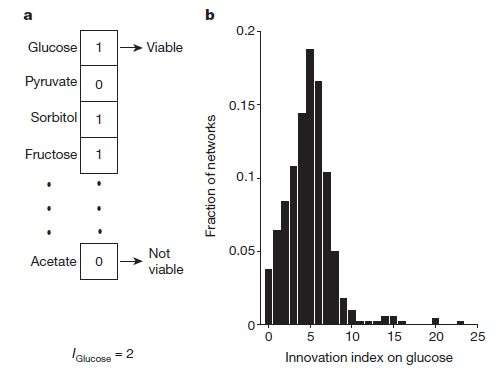July 15, 2013 report
Simulated metabolic networks show exaptations far outnumber adaptations

(Phys.org) —A pair of researchers from the University of Zurich in Switzerland has found that pre-adaptive traits, (which they call exaptations) appear to be far more common than adaptive traits. In their paper published in the journal Nature, Aditya Barve and Andreas Wagner describe how they created simulated metabolic networks to show that exaptations are far more common than has been thought.
Most everyone is aware of adaptations in nature—they are at the core of biological evolution. What's not so well known are exaptations, where traits are found that are actually adaptations of something that came before. The researchers suggest feathers are likely the most familiar example. Research has shown that they came to exist as a trait in organisms long before they were used in flight—likely as a means for keeping warm in a wet or moist environment. Another example they cite are crystallins in the human eye—they're a type of protein that helps the lens do its job. Prior research has shown that their original job was to synthesize different substances. Scientists have known about exaptations for some time—Darwin actually noted several examples. But what has not really been clear is how often traits are actually the result of pre-adaptive transitioning.
To find out, the two researchers created several metabolic simulations each with a single carbon source. By adding other environmental factors such as oxygen, ammonium, phosphates, etc. they were able to build simulations of metabolic networks capable of synthesizing 50 different kinds of biomass all based on different sources of carbon. Afterwards, subsequent trials revealed that all of them were able to synthesize more than one type of biomass, despite being programmed to synthesize just one—examples of exaptation. This they say, shows that exaptations occur far more often than has been thought, and that it's likely they are more common than simple adaptive traits.
The two researchers suggest their findings indicate that it might be impossible in many situations to distinguish between adaptation and exaptation when looking at traits in modern organisms. This means, they say, that going forward scientists may have to rethink the evolutionary process because natural selection might play a slightly different role than has been believed.
More information: A latent capacity for evolutionary innovation through exaptation in metabolic systems, Nature (2013) doi:10.1038/nature12301
Abstract
Some evolutionary innovations may originate non-adaptively as exaptations, or pre-adaptations, which are by-products of other adaptive traits. Examples include feathers, which originated before they were used in flight, and lens crystallins, which are light-refracting proteins that originated as enzymes6. The question of how often adaptive traits have non-adaptive origins has profound implications for evolutionary biology, but is difficult to address systematically. Here we consider this issue in metabolism, one of the most ancient biological systems that is central to all life. We analyse a metabolic trait of great adaptive importance: the ability of a metabolic reaction network to synthesize all biomass from a single source of carbon and energy. We use novel computational methods to sample randomly many metabolic networks that can sustain life on any given carbon source but contain an otherwise random set of known biochemical reactions. We show that when we require such networks to be viable on one particular carbon source, they are typically also viable on multiple other carbon sources that were not targets of selection. For example, viability on glucose may entail viability on up to 44 other sole carbon sources. Any one adaptation in these metabolic systems typically entails multiple potential exaptations. Metabolic systems thus contain a latent potential for evolutionary innovations with non-adaptive origins. Our observations suggest that many more metabolic traits may have non-adaptive origins than is appreciated at present. They also challenge our ability to distinguish adaptive from non-adaptive traits.
Journal information: Nature
© 2013 Phys.org


















